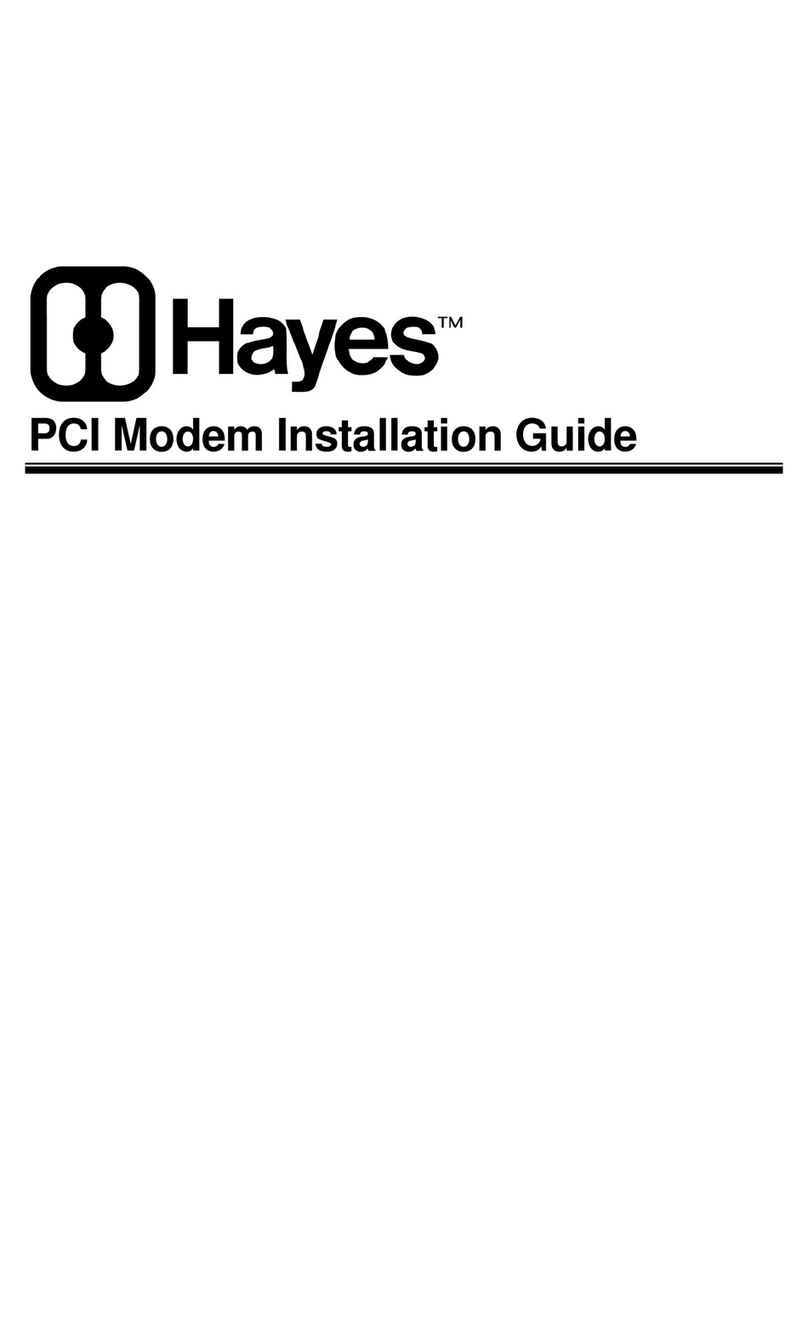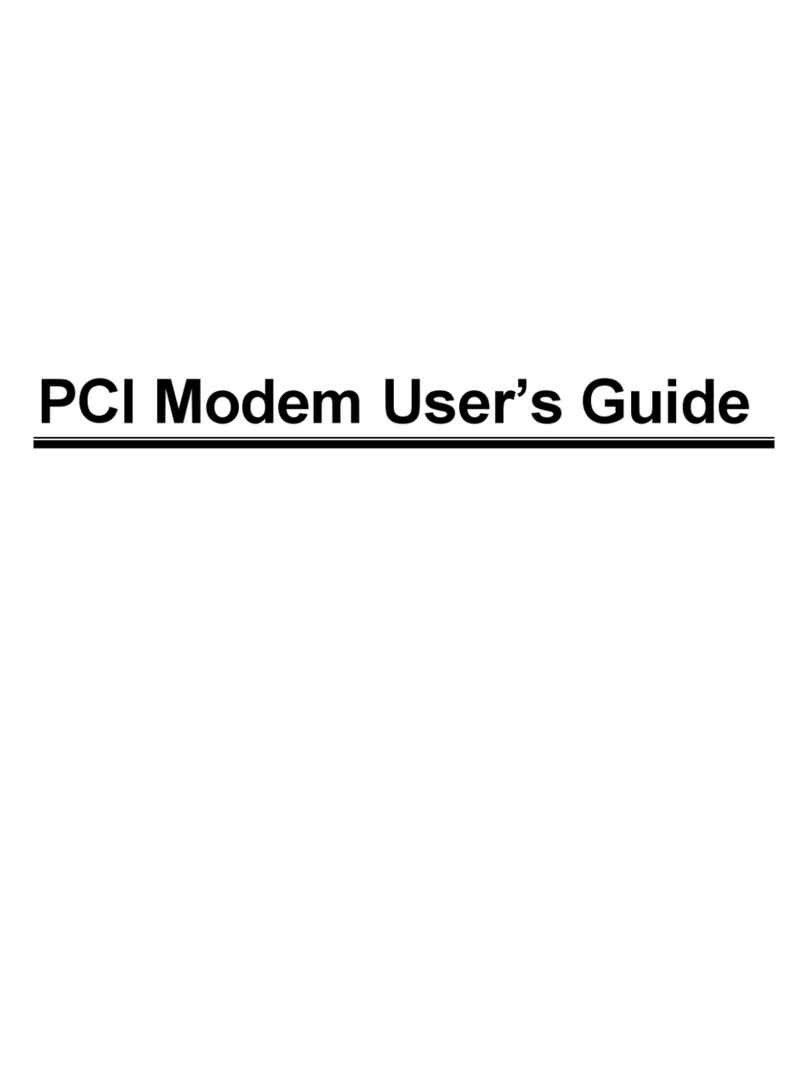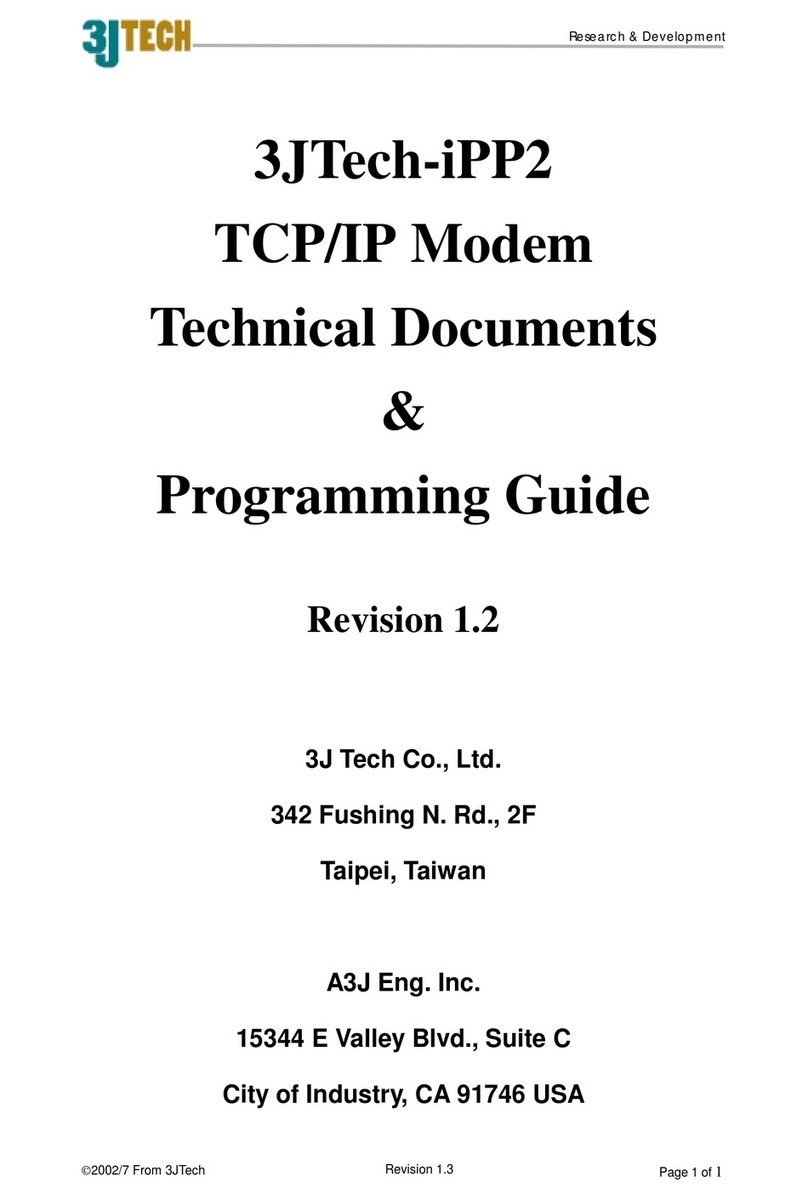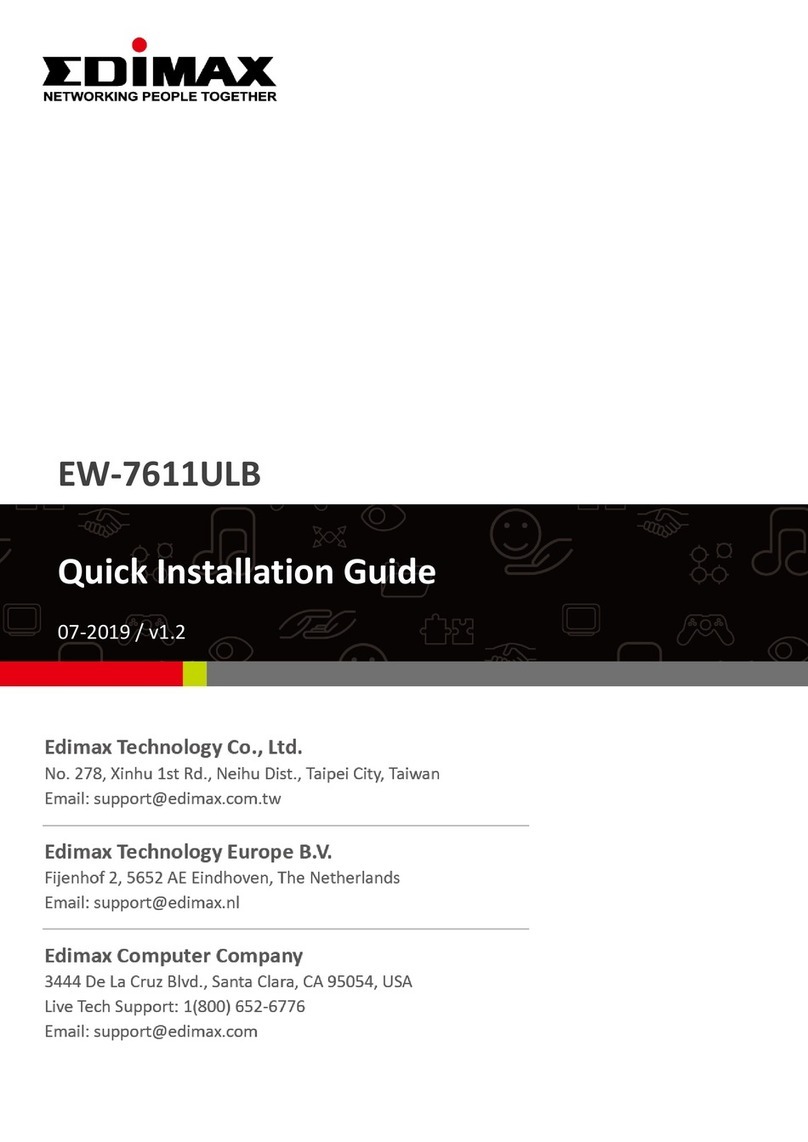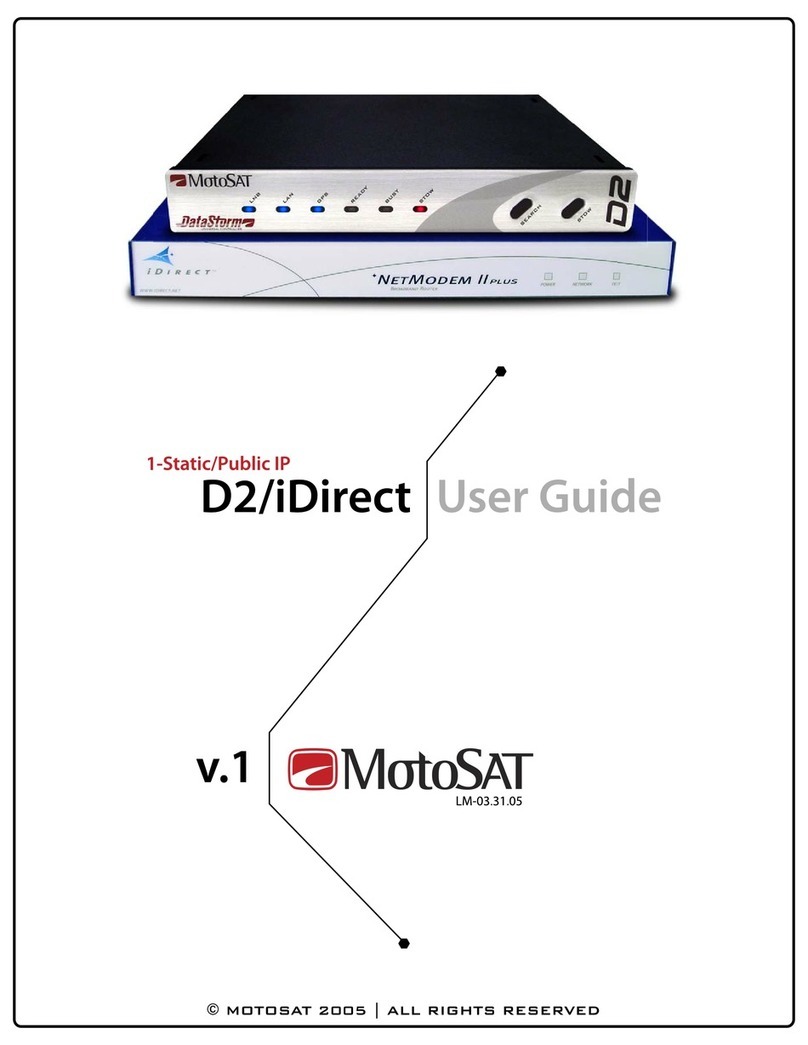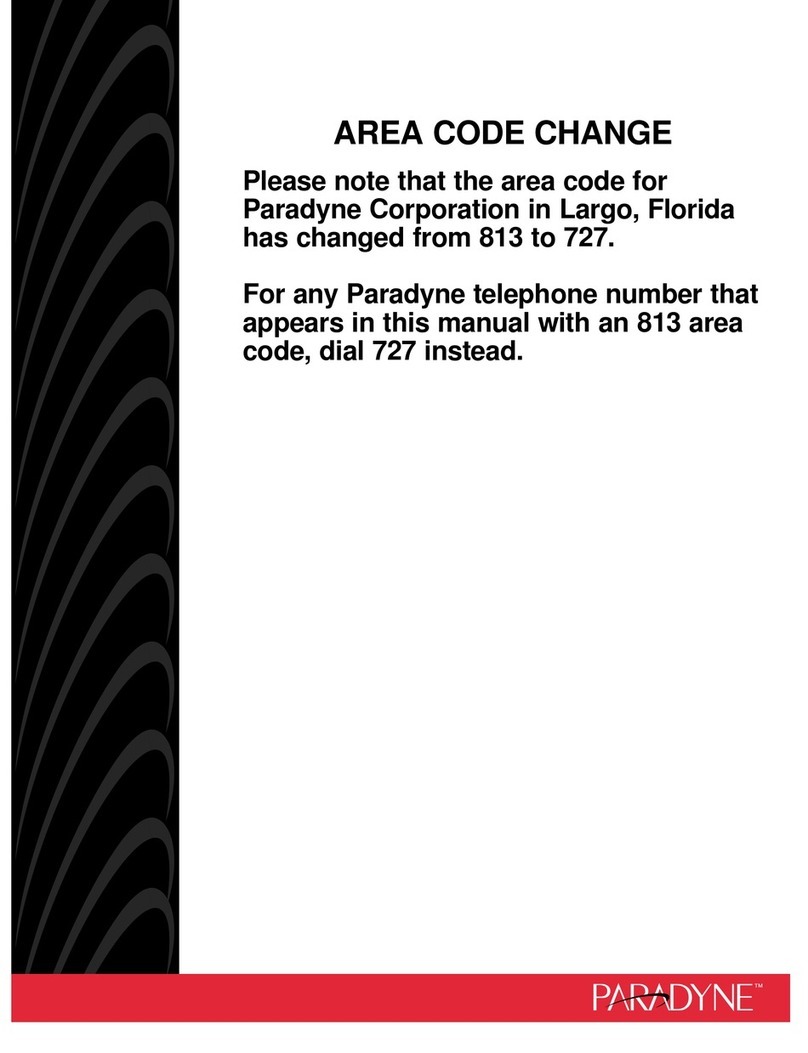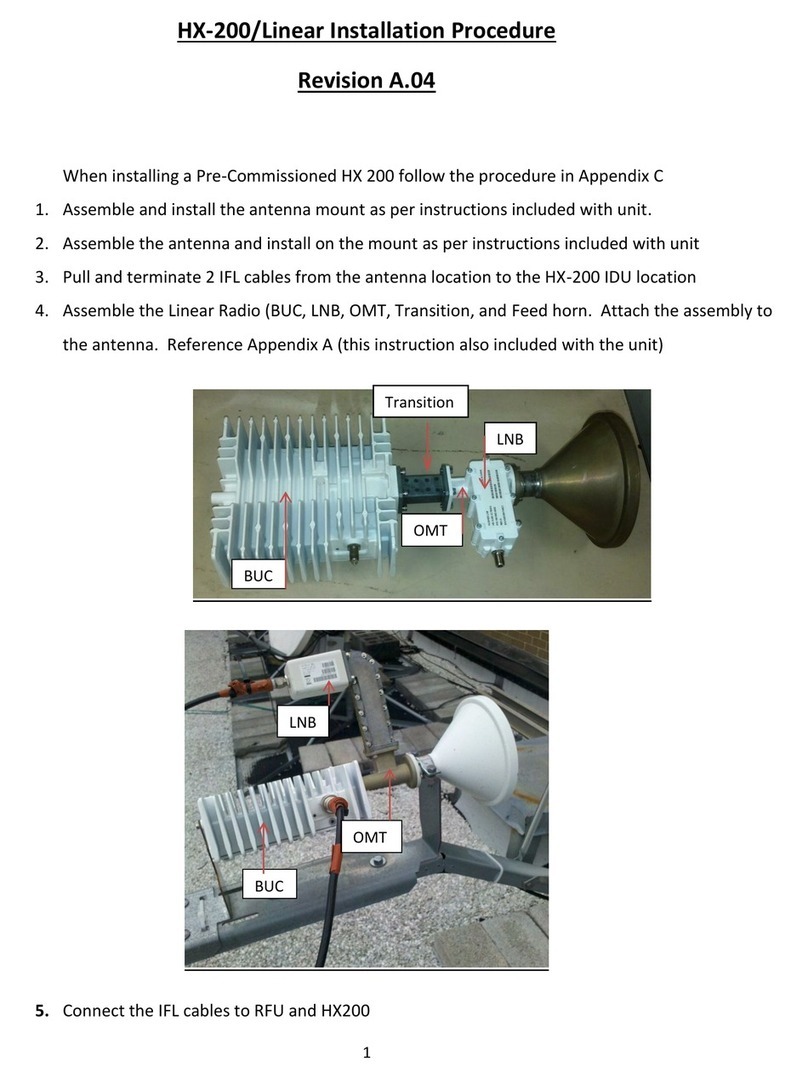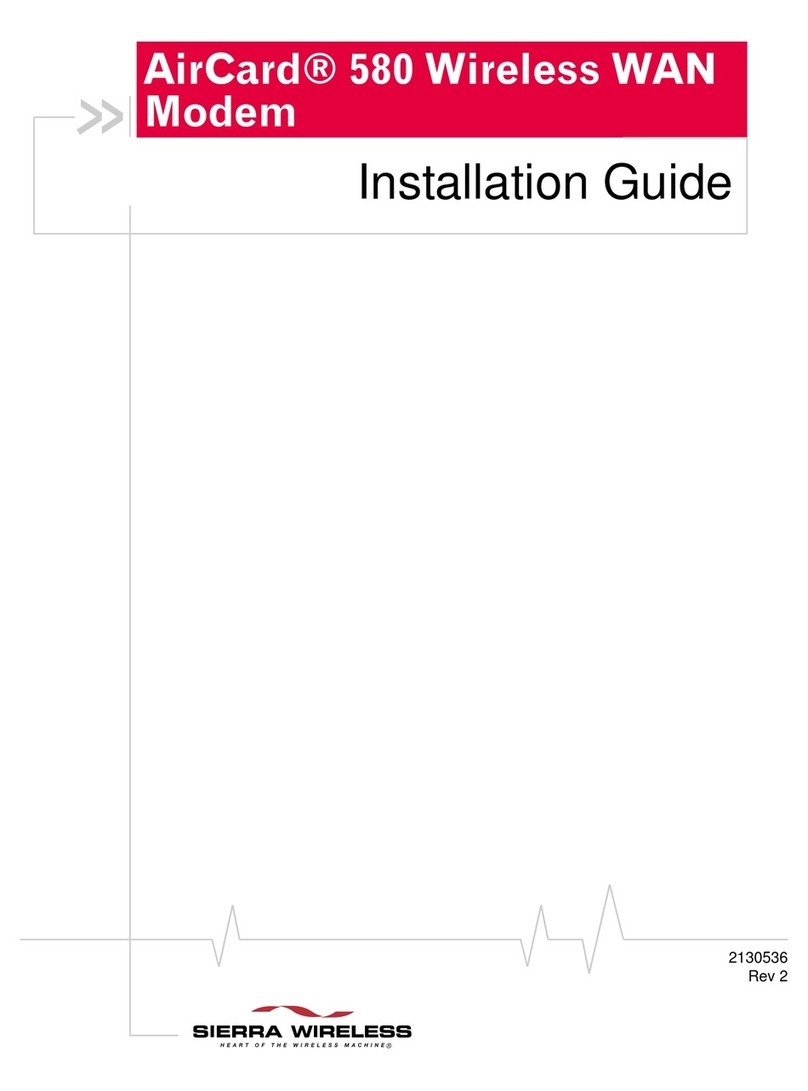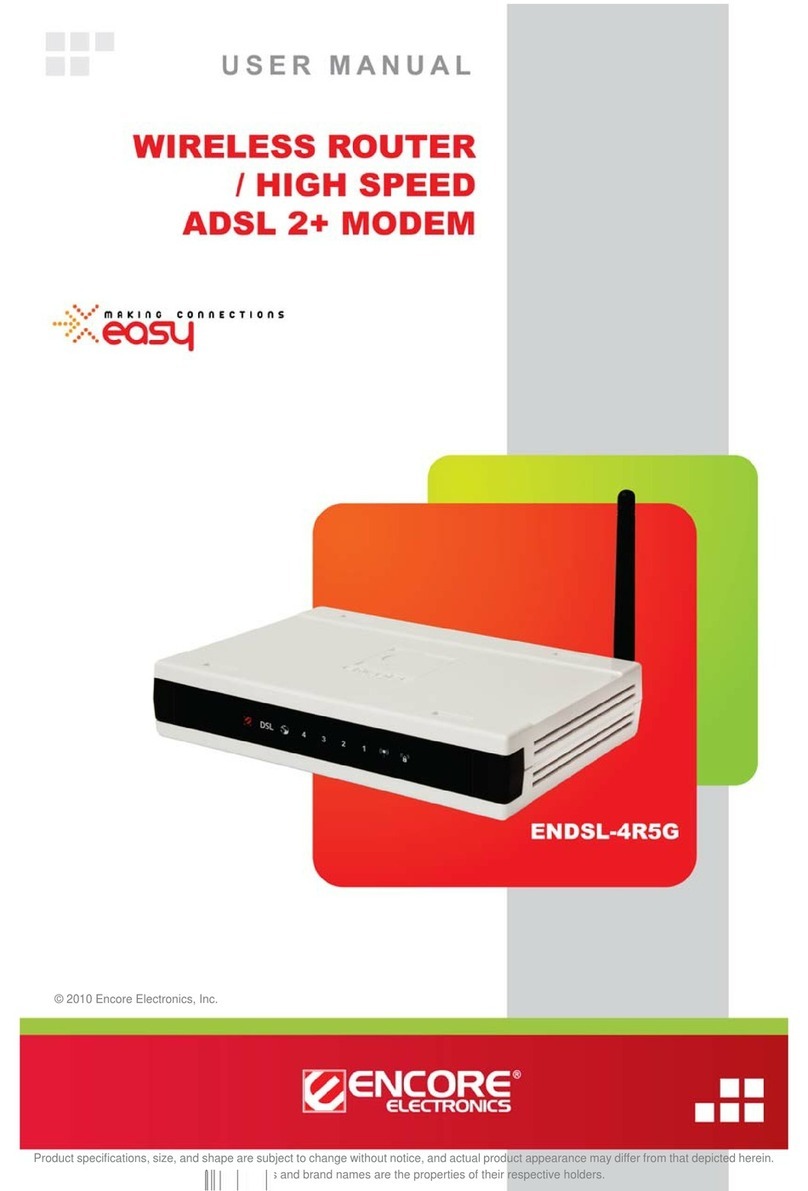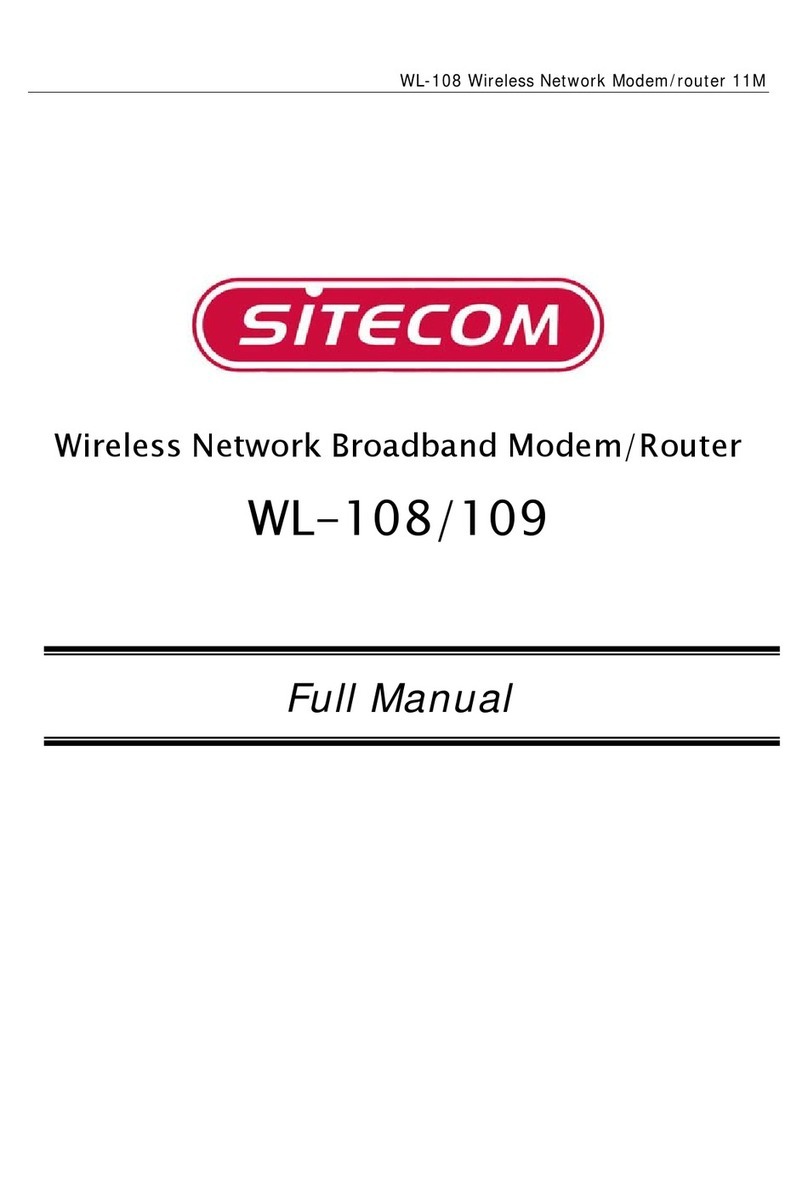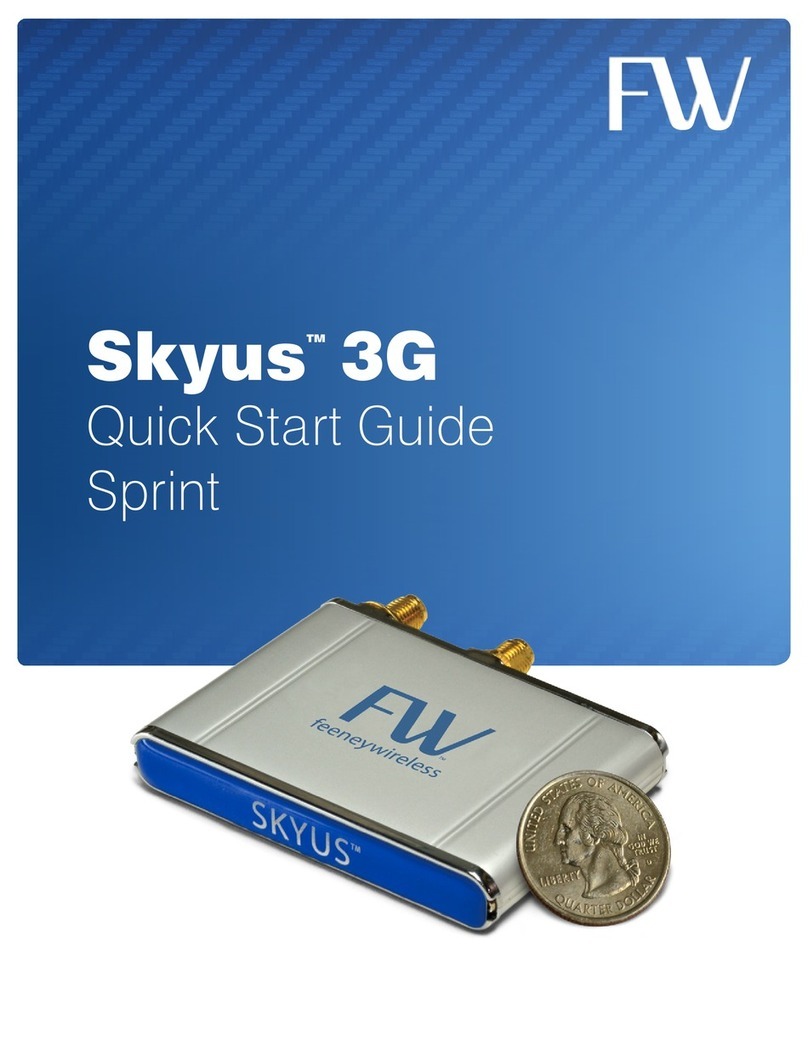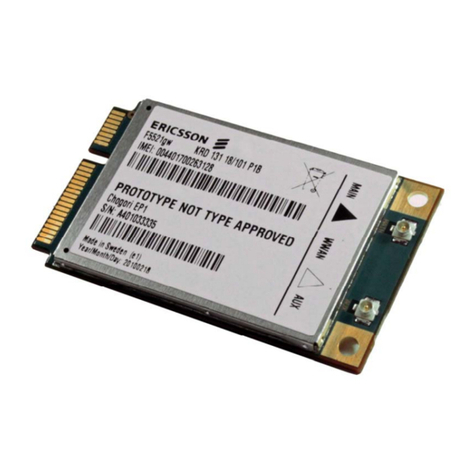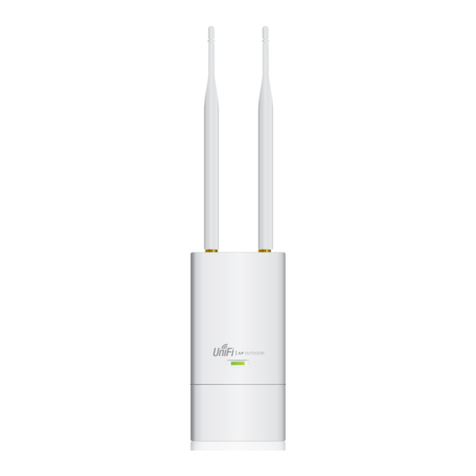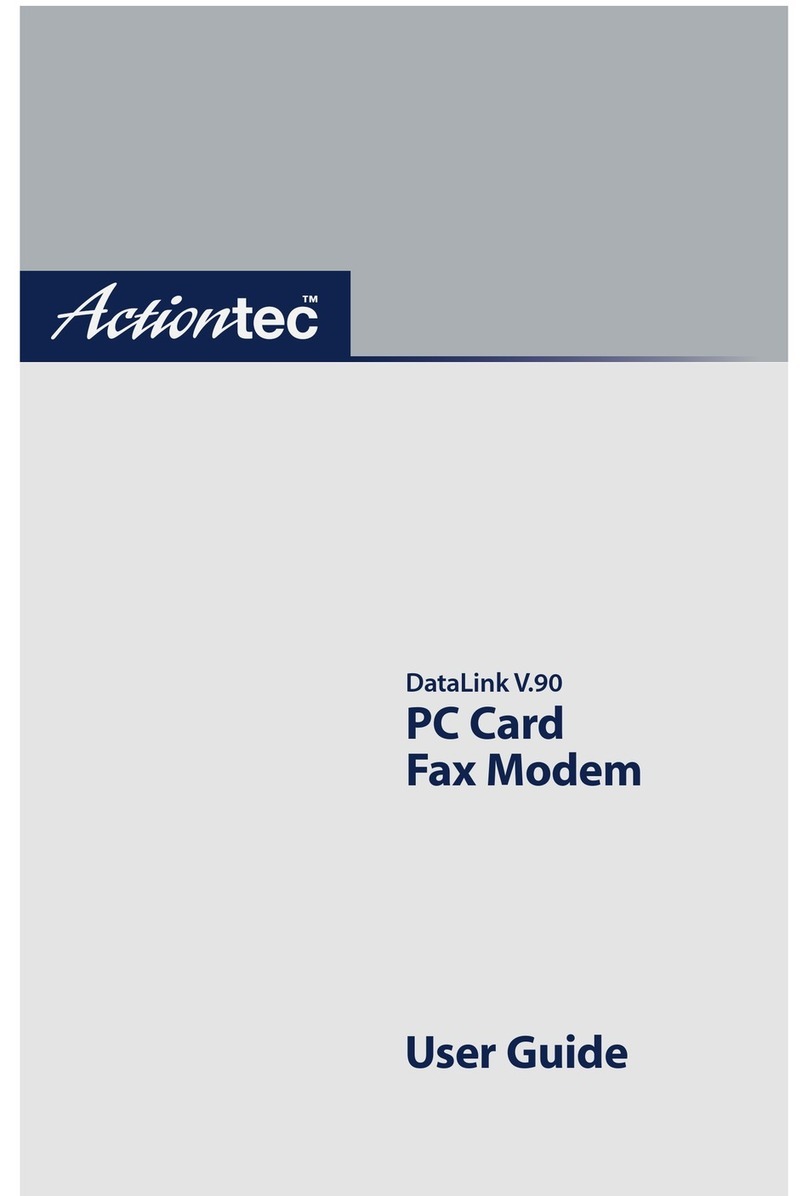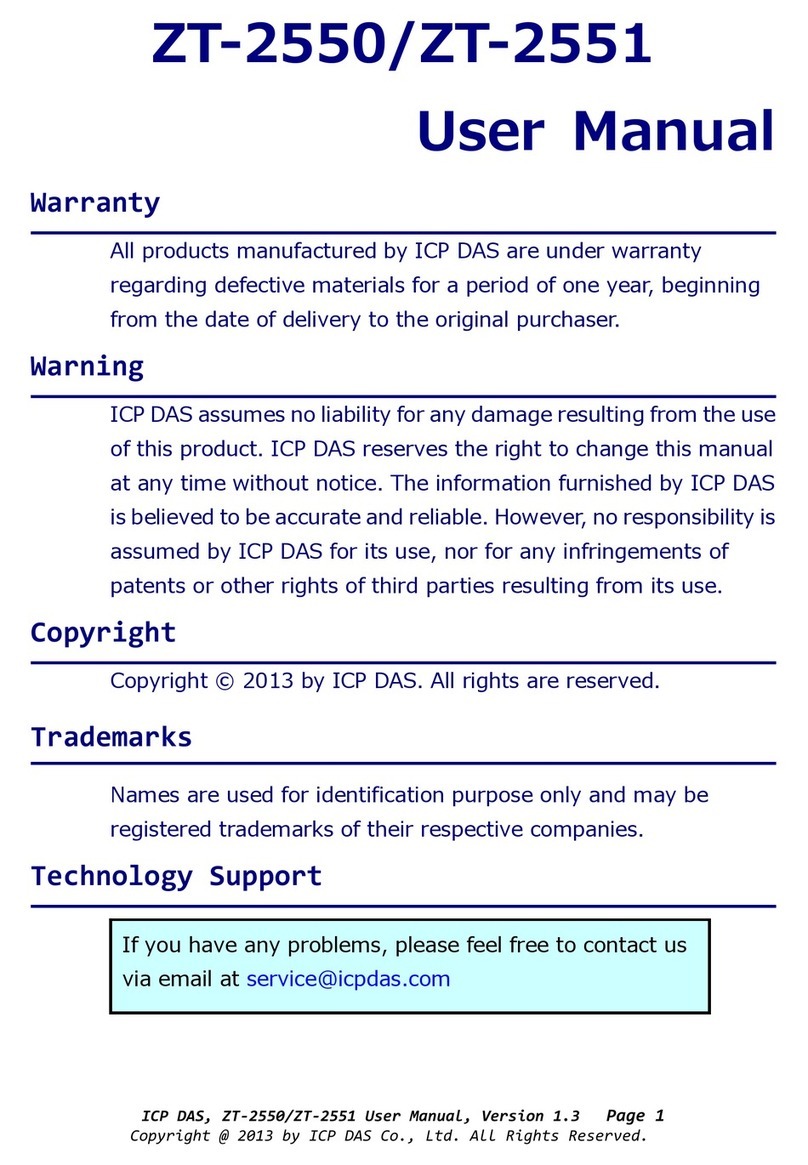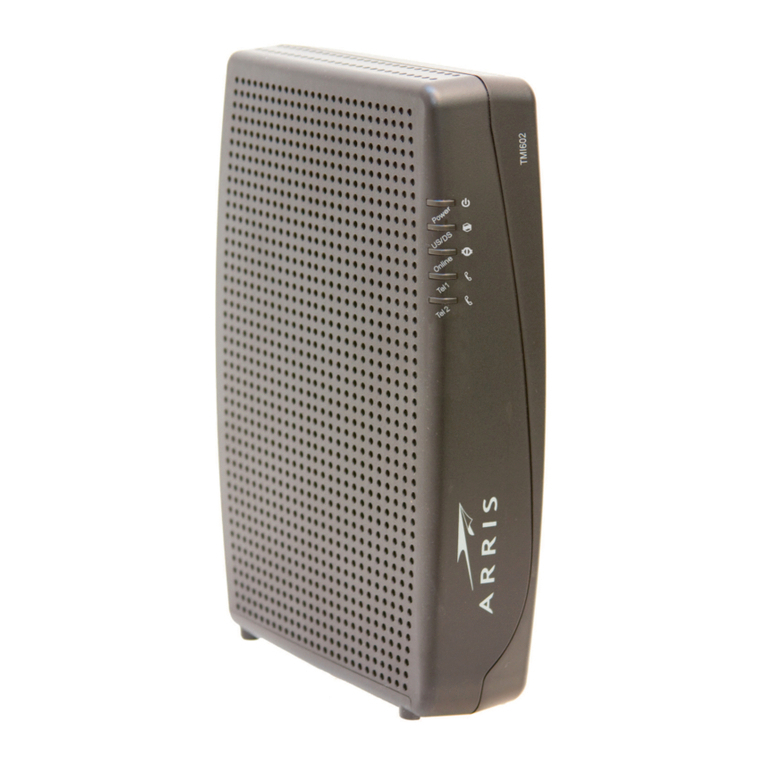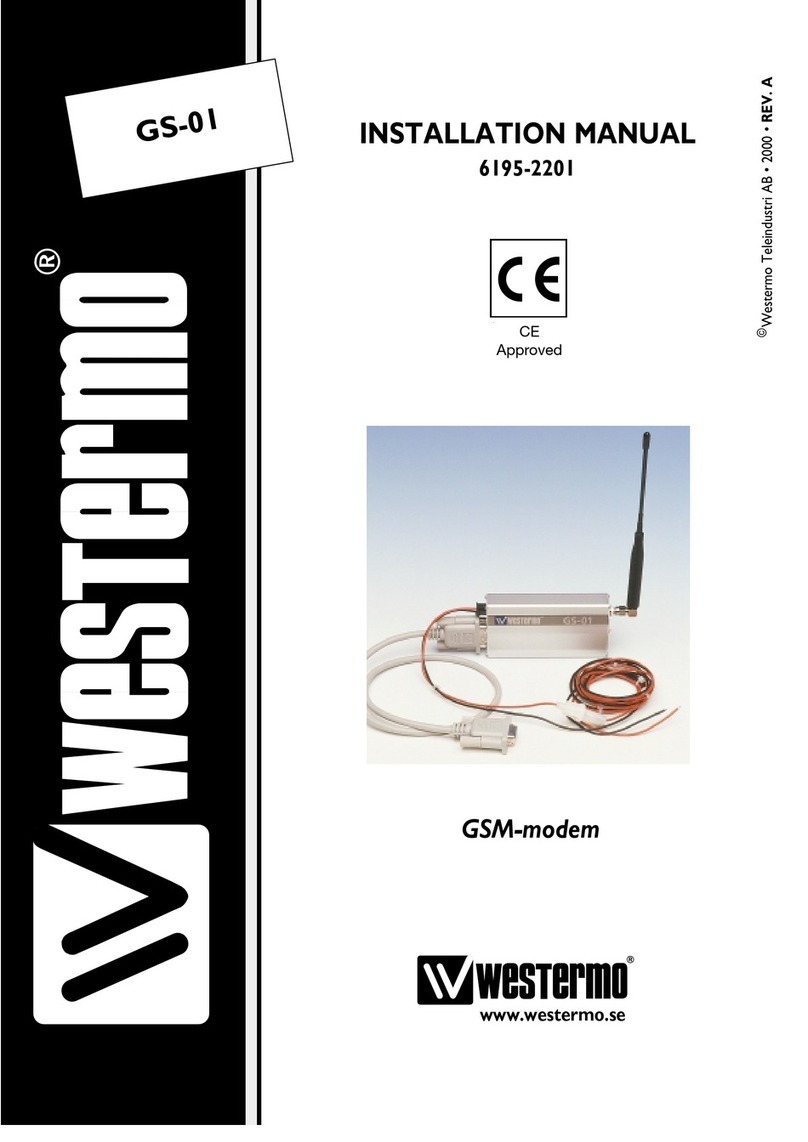Hayes PCI Modem User manual

PCI Modem User Guide

NOTICE
This document contains proprietary information protected by copyright, and
this User’s Manual and all the accompanying hardware, software, and
documentation are copyrighted. All rights are reserved. No part of this
document may be photocopied or reproduced by mechanical, electronic, or
other means in any form.
The manufacturer does not warrant that the hardware will work properly in
all environments and applications, and makes no warranty and representa-
tion, either implied or expressed, with respect to the quality, performance,
merchantability, or fitness for a particular purpose of the software or docu-
mentation. The manufacturer reserves the right to make changes to the
hardware and User’s Manual content without obligation to notify any person
or organization of the revision or change.
All brand and product names are the trademarks of their respective owners.
© Copyright 2001. All rights reserved.

Contents
INTRODUCTION .................................................................... 4
WHAT YOU NEED TO USE YOUR FAXMODEM................................ 4
INSTALLING YOUR PCI FAXMODEM.................................. 5
WINDOWS 95/98/ME/2000.......................................................... 5
WINDOWS NT 4.0....................................................................... 5
INSTALLING THE DRIVERS ........................................................... 5
INSTALLING THE FAXMODEM CARD .............................................. 7
COMPLETING THE INSTALLATION ................................................. 9
IMPORTANT INFORMATION FOR OWNERS OF V.92
MODEMS .............................................................................. 11
FIRMWARE UPGRADES.............................................................. 12
COMMUNICATING WITH YOUR FAXMODEM .................. 13
ACCESSING THE INTERNET ........................................................ 13
COMMUNICATION SETUP OPTIONS............................................. 13
INITIALIZATION STRINGS AND AT COMMANDS............................. 14
TROUBLESHOOTING ......................................................... 16
PLUG AND PLAY SETUP PROBLEMS WITH WINDOWS .................. 16
OTHER TROUBLESHOOTING TIPS............................................... 19
APPENDIX A: HOW TO UNINSTALL MODEM
DRIVERS .............................................................................. 29
APPENDIX B. REGULATORY INFORMATION.................. 31
APPENDIX C: REFERENCE INFORMATION .................... 35

4 PCI Modem Installation Guide
Introduction
This Modem User Guide expands the Quick Start included with your
faxmodem package and contains all the information you should need
to use and troubleshoot your new modem. The Table of Contents
shows the various useful sections of this User Guide.
What You Need to Use Your Faxmodem
Make sure that you have received the following items in addi-
tion to this manual:
•PCI faxmodem
•Phone cord
•A CD-ROM disc or floppy diskette containing installation soft-
ware, modem drivers, and communications software.
You also need the following:
•Computer with 16 megabytes of RAM (32 MB recommended)
and a hard drive with at least 5 MB available
•An available PCI slot
•For software supplied on a CD-ROM disc, a CD drive
•Windows® 95, 98, Me, 2000, or NT 4.0 operating system
•A telephone jack to plug the modem into, so the modem can dial
out and receive calls
•Screwdriver or tool to remove and replace your computer cover.

Installing your PCI Faxmodem 5
Installing Your PCI Faxmodem
Windows 95/98/Me/2000
We have streamlined the installation of your modem by providing an
InstallShield® program that you must run before you install your
faxmodem card.
The InstallShield program installs driver files and sets up your com-
puter to recognize the new modem. When you restart your computer
after installing the modem, your hard drive will already contain the
files Windows needs to complete the installation. Please continue
with the Installing the Drivers section, page 5.
Windows NT 4.0
We have streamlined modem installation for Windows NT 4.0 com-
puters, but the installation sequence is the opposite of other Win-
dows operating systems. First you must install your new faxmodem
card in your computer, then run the InstallShield® program. To be-
gin, please go to the Installing the Faxmodem Card section on
page 7.
Installing the Drivers
1Your computer should be turned on. Close any applica-
tions you have running.
Insert the CD-ROM disc that came with your faxmodem
into your CD-ROM drive. The CD-ROM disc should auto-
matically start up in a few seconds and display an installa-
tion screen.
If the CD does not start automatically:

6 PCI Modem Installation Guide
•Click the
My Computer icon on your desktop; then
double-click the icon for your CD-ROM drive.
•If the installation program doesn’t start up immediately,
double-click launch.exe.
2When the installation interface appears, click the Install
Drivers button and then the PCI Drivers button.
For Windows NT, you will also see the following dialog
box. Make sure that the Install new modem driver and
components option button is selected and click Next.
The installation program will run and automatically copy
driver files to your hard drive. Click Finish if you are
prompted to do so.
3Windows 95/98/Me/2000 Users: Follow the instructions
for Installing the Faxmodem Card on page 7.
Windows NT 4.0 Users: Please go to Completing the
Installation on page 9.

Installing your PCI Faxmodem 7
Installing the Faxmodem Card
Follow the steps below to install your faxmodem card.
Note: If your computer has an existing modem, we recommend
that you first uninstall the modem drivers. Please refer to
Appendix A on page 29.
1Before you start the hardware installation, close all
running programs and shut down Windows if you
have not already done so. Then turn your computer
off and unplug it. Don’t plug it back in or turn it on until
you complete the faxmodem hardware installation.
2Take the cover off your computer.
Note: If you no longer want your older modem in your
computer, you should remove it now. First unplug any
phone cords connected to the card. One cord is the con-
nection to your telephone. You can reuse this cord with
your new faxmodem. The other cord is the connection to
your telephone line at a wall jack. It is a good idea to re-
place this cable with the one that came with your new faxmo-
dem. Then remove the screw that is holding the modem
card in place and slide it out.
3On the rear of the computer, unscrew and remove the
metal cover plate that lines up with a free PCI slot.
CAUTION
Do not handle any internal modem card when the phone line is
plugged into it. The voltage present when the line is ringing is poten-
tially harmful.

8 PCI Modem Installation Guide
CAUTION
Electrostatic Discharge Protection
Static electricity can damage modem compo-
nents or your computer. Before removing the
modem from its antistatic bag, touch the com-
puter’s metal chassis to statically discharge your-
self.
4Remove your new faxmodem from its antistatic bag and
record its serial number in the table on page 35 of this
manual.
5Slide the faxmodem card firmly into the free PCI slot. See
the following illustration:
PCI slot
16-bit
ISA slots
Typical cover
plate
Be sure that the back end of the card (smaller gold finger
area) is properly seated into the connector. If you have a
tower or mini-tower computer case with a vertical main
board, lay the computer down on its side so you can push
straight down on the modem card to seat it firmly in its
slot. Be sure that the bracket is lined up properly, then

Installing your PCI Faxmodem 9
screw the bracket into the computer using the screw you
removed earlier.
6Replace the computer cover.
7Connect the telephone cord: Plug one
end of the phone cord into the jack
marked LINE. Plug the other end into a
phone jack (typically the wall jack where
you would normally connect a phone).
Plug your phone into the PHONE jack if
you want to use a phone on the same
line.
PHONE (optional)
LINE
LINE
PHONE
8Plug in your computer and turn it on.
9Windows 95/98/Me/2000 Users: As the Windows oper-
ating system starts up, it will detect your new faxmodem.
Because the installation program has already provided
your computer with the required files, you will see Win-
dows report on its progress, but it will not require any ac-
tion on your part. You may see a dialog box that says
Digital Signature Not Found. You can safely ignore this
message and click Yes. Continue below with Completing
the Installation.
Windows NT 4.0 Users: Please go to Installing the
Drivers on page 5.
Completing the Installation
Turn your computer back on and perform the following steps:
1Open Control Panel and double-click the Modems or
Phone and Modems icon. Click the entry for your new
modem and then click the Properties button.
Set the Maximum speed to the highest speed available
(probably 115,200). This sets the speed at which the

10 PCI Modem Installation Guide
computer communicates internally with the faxmodem.
2Click the Diagnostics tab. Highlight the port next to the
entry for your new faxmodem and click More info or
Query Modem.
Note the Port and Interrupt entries under Port Informa-
tion and write the information in the Reference Informa-
tion table on page 35.
This step tests the modem by querying it with AT com-
mands. A list of responses means that your new modem
is properly connected.
IMPORTANT: If you already have a modem installed in your com-
puter, you’ll need to redirect your application software so that it rec-
ognizes your new modem. Please turn to page 16 for instructions.
Otherwise, continue with Installing the Communications Software
below.
Tip: If you determine that your faxmodem is not working, first try
turning off your computer and restarting it. Sometimes this
will help Windows identify and activate the correct drivers. If
restarting your computer doesn’t work, please consult the
Troubleshooting section on page 16.
Installing the Communications Software
The modem’s CD describes the communications software package
and online service included with your modem and provides easy
point-and-click installation. If necessary, consult the CD’s online help.
Please run the modem’s CD now. You should not install the drivers
again, but you should install any application software you like.
If you have a V.92 modem, after you’ve installed the CD software,
you should read the Important Information for Owners of V.92
Modems section of this manual on page 11. If you don’t have a V.92
modem, you’re done! Enjoy your modem.

Important Information for Owners of V.92 Modems 11
Important Information for Owners of
V.92 Modems
With V.92, as with the earlier V.90 standard, your connection speed
depends on your phone line and your Internet Service Provider (ISP).
To enhance compatibility, this modem automatically detects whether
to use V.92, V.90, or a slower mode when it connects to your ISP.
Your V.92 modem includes the following capabilities.
•QuickConnect:
A V.92 modem remembers the line conditions of the last number
called, and uses this information to try to reduce connection
times.
•Modem-on-Hold:
You have the option of receiving voice calls while online. You can
answer the call and put your Internet session on hold if your ISP
supports this capability and you have Call Waiting service com-
patible with the modem.
•Faster Upload Speeds:
Upload speeds may be increased, from 33.6K bps to a maximum
of 48K bps. (Actual rates vary, depending on line
conditions.)
•V.44 Data Compression:
The V.44 standard lets you browse the Web and transfer data at
higher speeds.
To make the most of your V.92 modem, follow these steps:
1. Contact your ISP and get the phone number of a V.92 connec-
tion to the ISP.
2. Check our web site for news of any V.92 updates. If an update is
available, follow the directions below for upgrading your modem.
Note: If you want to manually change the way your modem con-
nects, please consult the AT command tables beginning on
page 24 in the Troubleshooting section.

12 PCI Modem Installation Guide
Firmware Upgrades
Your modem’s software, or “firmware,” can be easily upgraded. This
is useful for code updates and feature enhancements. To upgrade
your modem’s firmware, you simply download the new firmware files
from our Web site and then run a program we provide. Before calling
your first V.92 site, we strongly suggest that you download the latest
firmware.
We also suggest that you register your modem with us so that we
can notify you via e-mail when new firmware releases are available.

Communicating with your Faxmodem 13
Communicating with your Faxmodem
The faxing and communications software that came with your fax-
modem sets itself up automatically and takes care of sending any
necessary commands to the modem.
You should read this section, however, if you want to learn some
general facts about how software works with your faxmodem, or if
you intend to use your new modem with other software.
Accessing the Internet
To access the Internet and the World Wide Web, you need an online
service such as America Online (AOL) or CompuServe, or an Inter-
net Service Provider (ISP). The best place to start is the CD included
with your modem package, which contains Internet and online serv-
ices for you to try.
Online services provide installation software that makes signing up
almost automatic. ISPs typically supply or suggest the browser soft-
ware needed to access their service. They also provide additional in-
structions and software for setting up your account.
Note: You may need to redirect your application software to recog-
nize your new modem; refer to the Troubleshooting section, page
16, if you need assistance.
Communication Setup Options
If you run into configuration difficulties with your communication soft-
ware, it may be helpful to read the following section.
In setting up some older software programs, you may be asked to
enter certain information. Most programs have default settings that
are correct for use with this modem, and there is no need to change
them. However, you should be aware of the following items:

14 PCI Modem Installation Guide
If you are asked to select the “modem type” from a menu, and you
don’t see this modem listed by name, select the most descriptive
name such as V.92 modem, 56K modem, or generic Class 1 Mo-
dem.
In the dialing directory, set all entries to the highest possible baud
rate, if your software and serial port support these speeds (do not go
over 115,200 bps). All communications between the computer and
the faxmodem take place at this higher speed, independent of the
modem-to-modem speed.
If there is a section of your software called “Terminal Settings,” make
sure that Hardware Flow Control (RTS/CTS) is ON (or YES).
Set auto baud detect to OFF (or NO).
If your fax software gives you the option of selecting Class 1 or
Class 2 fax drivers, select Class 1.
Finally, some programs ask Send init if CD high?, which you should
set to YES. Otherwise, the faxmodem may not receive the proper ini-
tialization string.
Initialization Strings and AT Commands
An initialization string is a group of AT command settings that is sent
to the faxmodem as soon as you start up the software. The software
determines which commands should be included in the initialization
string, based on the device you select during installation. The com-
mands remain in effect throughout the communications session, un-
less the software sends other commands to override them.
The software uses other AT command strings for all commands sent
to the modem. This is transparent to you—the software does this in
the background without you being aware of it.
It is sometimes necessary, however, to add other AT commands to
initialization strings. You can find a table of AT commands on the
World Wide Web at www.modems.com. Click Reference and then
on AT Command Sets.

Communicating with your Faxmodem 15
If your software suggests an initialization string for this modem, you
should use it. If your software does not list this modem and no initiali-
zation string is suggested, use the following: AT &F.
Your telephone service may include Call Waiting that you can tempo-
rarily suspend by using your phone to dial a special code. (For ex-
ample, in the U.S., you can disable call waiting by adding *70 to your
dialing prefix; please check with your local phone company for the
correct code for your area.) You can include that code, followed by a
comma, in the dial string or dial prefix in your software.
If your software does not handle AT commands automatically, it
should provide a place to enter AT commands in its setup menus.
However, in some cases you may need to enter AT commands di-
rectly to the faxmodem. You must do so from a data program’s ter-
minal mode.
Refer to the Troubleshooting section for more tips about AT com-
mands.
Using Terminal Mode to Enter AT Commands
Start your data communications program.
Change to terminal mode (also called command, local, direct, or
dumb mode). Check your software documentation for additional in-
structions.
Type AT plus the command you need and press Enter. You will see
an OK response.
When you finish, you can return to the data communications pro-
gram’s standard user interface. See the software program’s docu-
mentation if you need help.
To return to the factory default settings for the modem, in terminal
mode, type AT &F and press Enter.

16 PCI Modem Installation Guide
Troubleshooting
If your modem stops working, please read this section carefully be-
fore calling Customer Support. In addition, your modem CD includes
a list of Frequently Asked Questions (FAQs).
Important—If Your Computer Has an Existing Modem
You must redirect your application software so that it recognizes your
new modem. To do so, follow these instructions:
•Dial-up Networking Users:
From your computer’s desktop, double-click the My Computer
icon and then the Dial-up Networking icon. Double-click the
Make New Connection icon, select your new V.92 modem from
the dropdown list, and follow the prompts.
•America Online Users:
From within AOL, click the Setup button; then click the Expert
Setup button. Select the Devices tab and double-click the new
V.92 modem you’ve installed. Click OK and then Close.
Plug and Play Setup Problems with Windows
Under some circumstances, the Plug and Play setup under Windows
95/98/Me/2000 may not resolve all installation problems. The Win-
dows Help system has an excellent tool for thoroughly diagnosing
and solving many problems.
1. On your desktop, double-click the My Computer icon.
2. Choose the Help Topics command in the Help menu. Win-
dows displays the Windows Help dialog box.
3. Select the Contents tab. Note: Windows Me and 2000 include
a Help Search option, which you can use instead; search for
“hardware conflict,” for example.

Troubleshooting 17
4. Click Troubleshooters. (For Windows 98, you will also have
to click Windows 98 Troubleshooters.) Then click the hard-
ware conflict help entry.
5. Follow the instructions for determining and resolving a hard-
ware conflict.
This should solve your problem. Remember to write down your COM
port setting. Return to page 9 to complete the installation.
If you still have problems, it probably means that although you are
running a version of Windows that supports Plug and Play, you may
have an older computer that is not completely compatible with this
feature. Try the steps in the next section.
Freeing up Resources in BIOS under Windows 95/98/Me/2000
This procedure is a little more difficult than the previous one, but with
the help of your computer’s documentation you should be able to
clear up any remaining problems.
1. Close all running programs. Shut down your computer and re-
start it: Click Start and then Shut Down. Shut down your
computer completely. Turn the power off, wait about 5 sec-
onds, and turn the power back on.
2. As your computer goes through the startup process, it should
display a key or key combination that you can use to enter the
BIOS Setup program. Enter the BIOS Setup program and dis-
able COM2. Consult your computer’s documentation if the
procedure is not clear based on the on-screen prompts. Note:
Some computers may not use the BIOS settings to control the
COM ports. Check your computer’s documentation to see if
you have to reset the computer’s jumpers or switches instead.
3. Write down and save the new COM port setting and exit
Setup.
4. The BIOS automatically reboots your computer.
5. Choose Control Panel from the Settings command in the
Start menu.
6. Double-click the System icon.

18 PCI Modem Installation Guide
7. Click the Device Manager tab.
Find the Ports (COM & LPT) device and click the +sign. This
expands the device list under Ports.
8. Select Communications Port (COM2). Click the Remove
button in the Device Manager window. This removes the de-
vice currently assigned to COM2.
9. When Windows displays the Confirm Device Removal
warning, click OK.
10. Double-click Modem in the Device Manager window.
11. Double-click the Faxmodem icon for your model.
12. Click the Resources tab.
13. Uncheck the Use automatic settings checkbox.
14. Scroll through the Basic configuration options until you find the
one that displays the Input/Output Range 02F8 - 02FF. This
is COM2. The Conflicting device list box should say No con-
flicts. If there are conflicts, call Tech Support.
15. If there are no conflicts, close the Modem Properties window,
System Properties window, and Control Panel window by
clicking OK for each.
16. Shut down your computer, turn off the power, and restart it.
Going through this power cycle can be important. Merely
restarting Windows may not allow the BIOS to register the
changes properly.
If Windows finds your other serial port, it may try to assign the port to
COM2, but won’t be able to because your faxmodem is already using
that system resource.

Troubleshooting 19
Other Troubleshooting Tips
IMPORTANT:
If you need to reformat your hard drive or to reinstall
Windows 95/98/Me/2000, you must physically
remove your modem before doing so.
Install the drivers and then the modem as a new in-
stall, following the instructions in this manual.
Problem:Your system
−
−−
−doesn’t boot-up, or
−doesn’t recognize your PCI Faxmodem, or
−doesn’t respond in Control Panel | Modems | Di-
agnostics.
Solution:Your PCI Faxmodem is a BIOS and driver-dependent
device. Sometimes the modem will be mistakenly as-
signed to an IRQ (Interrupt Request) already in use by
another device.
If you install the modem in a different slot in your com-
puter, this may solve the problem.
You should also check your computer for an available
IRQ if you have other devices connected to your com-
puter. Go to Settings | Control Panel | System | De-
vice Manager. Highlight Computer, press Properties,
and check for an available IRQ. Any IRQ from 0 to 15
which does not already have a device assigned to it is
available for use.
Win95B, Win98, WinMe, and Win2000 Users: When
PCI bus IRQ steering is enabled, Windows will direct PCI
bus IRQs to devices such as your modem. Sometimes,
however, the IRQ that Windows assigns to your modem
will conflict with the computer’s BIOS.
To disable IRQ steering in computers running these
operating systems, from Control Panel, go to System
| Device Manager | System Devices | PCI Bus | IRQ

20 PCI Modem Installation Guide
Steering and click the option button to disable IRQ
steering. If the PCI modem you have just installed is
listed, highlight it and click Remove, and then reboot
your system. If this doesn’t disable the “IRQ Holder for
PCI Steering,” please contact Microsoft Technical Sup-
port.
Assigning an IRQ: Only computers with an updated
BIOS will be able to assign an available IRQ to the PCI
slot on the motherboard. Check your computer’s docu-
mentation, or the motherboard itself, for the number of
the PCI slot.
If you have a VIA Chip-based motherboard: Comput-
ers with this chipset, particularly those running Windows
98, frequently have problems installing PCI modems
unless the VIA IRQ Routing Miniport Driver is installed.
If your computer’s user’s manual doesn’t tell you if your
motherboard is VIA chipset-based, you need to look on
the motherboard itself to check. If you do have a VIA
Chip-based motherboard, you can download VIA’s IRQ
Routing Miniport Driver from:
www.via.com.tw/support/faq.htm.
Problem:Your modem seems to install under Windows 95, 98,
Me, 2000, or NT 4.0, but Windows cannot find it later.
Solution:If your computer has a built-in modem on the mother-
board, Windows may reinstall it the next time you start
up. Consult your computer’s documentation or call your
computer’s manufacturer to get instructions on how to
disable the built-in modem.
Problem: The software cannot find the modem and the modem
does not respond to AT commands. (The following
comment applies to many other problems as well.)
Solution:The most common error with modems is that the com-
munications software is not configured for the same
COM port as the modem. Check which COM port the
Other manuals for PCI Modem
1
Table of contents
Other Hayes Modem manuals
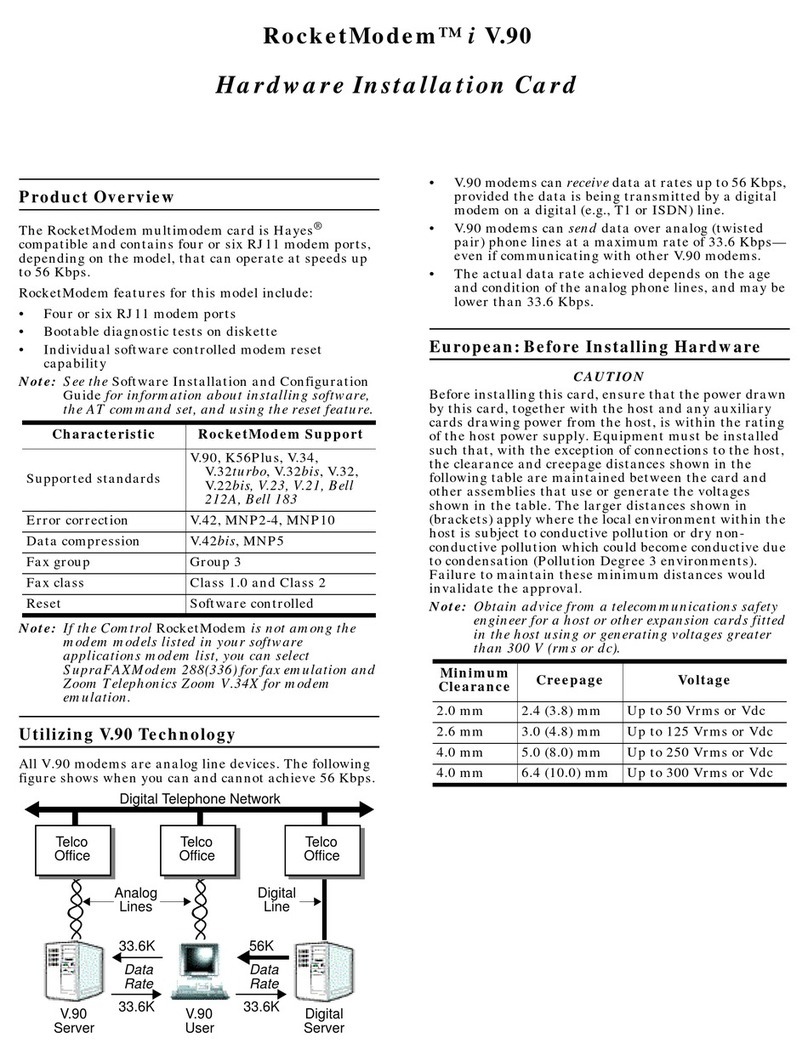
Hayes
Hayes RocketModem Manual

Hayes
Hayes V.92 User manual

Hayes
Hayes ADSL Duo Modem User manual
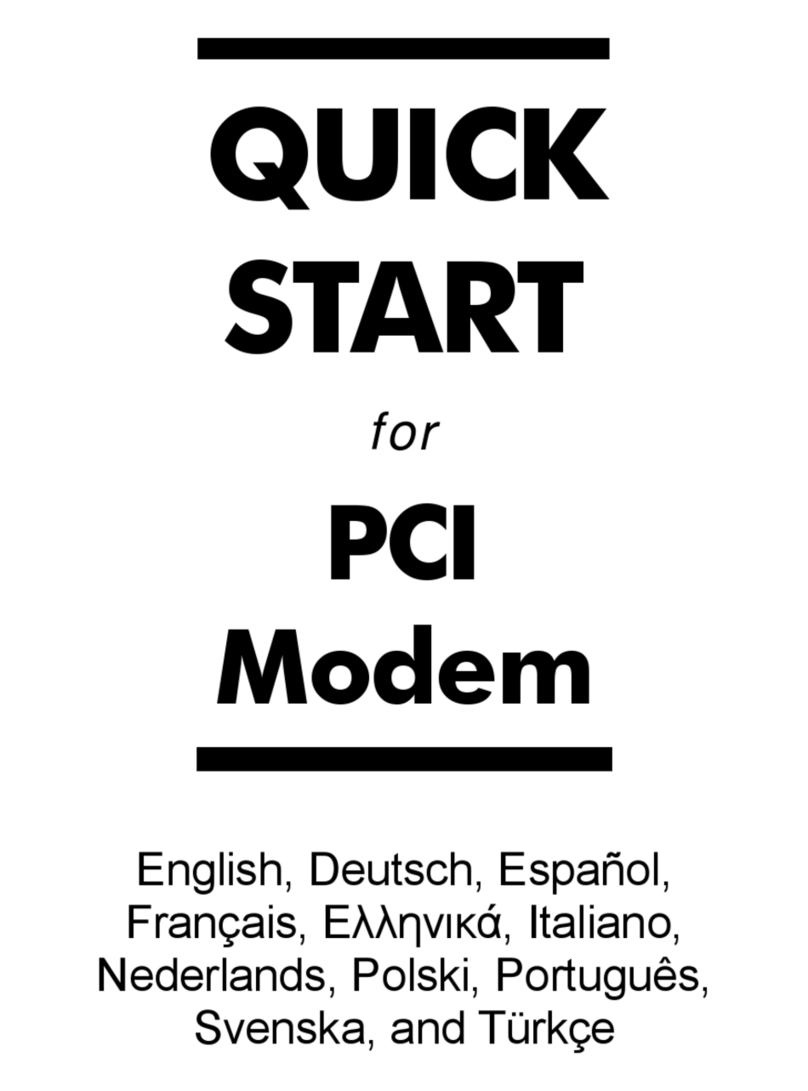
Hayes
Hayes PCI Modem User manual
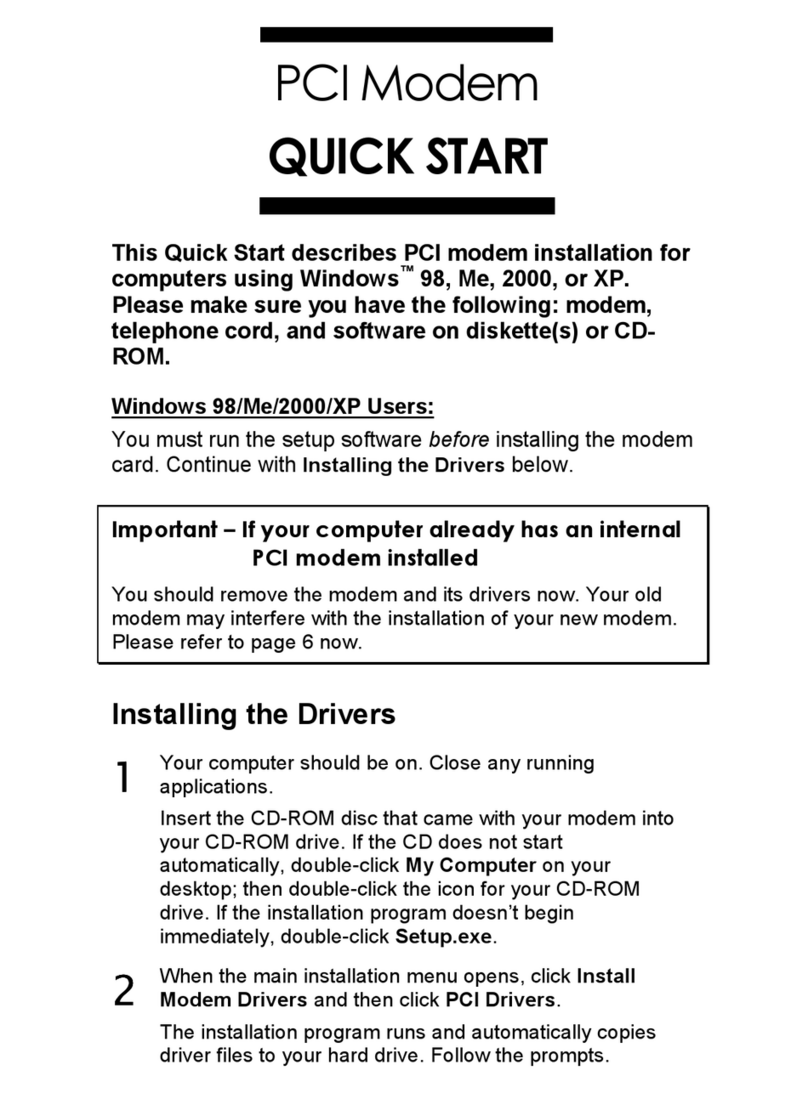
Hayes
Hayes H08-15531DF User manual
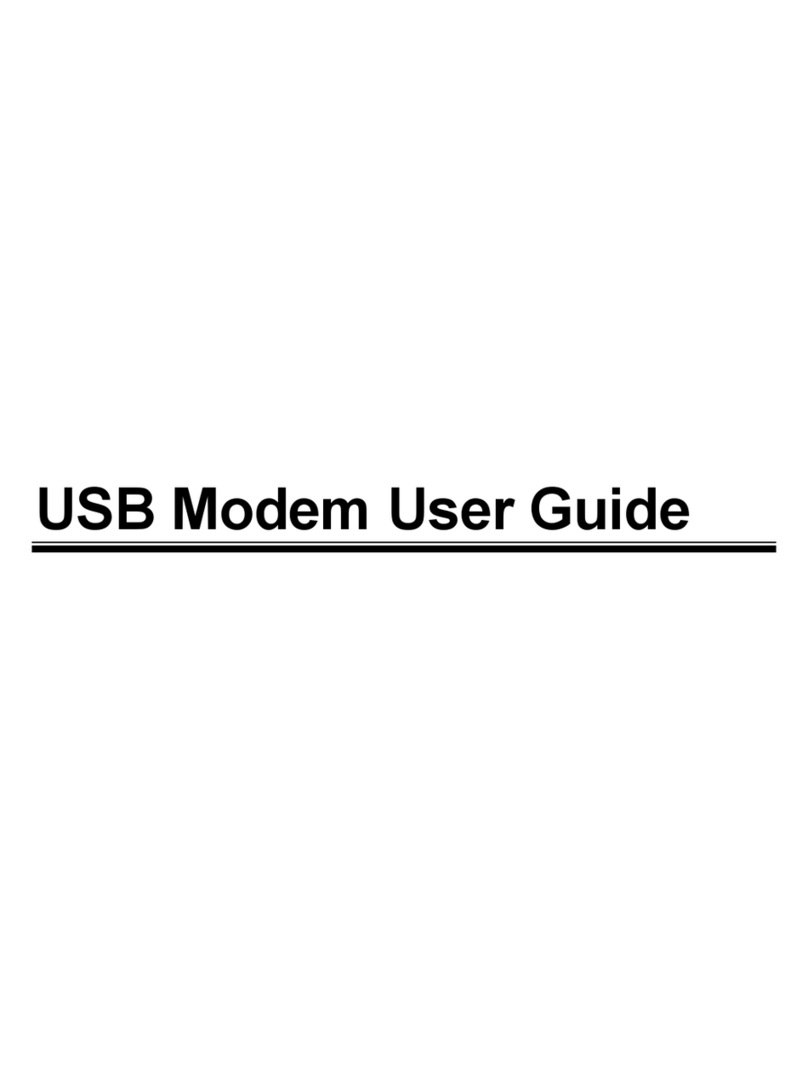
Hayes
Hayes USB Modem User manual

Hayes
Hayes V.92 User manual
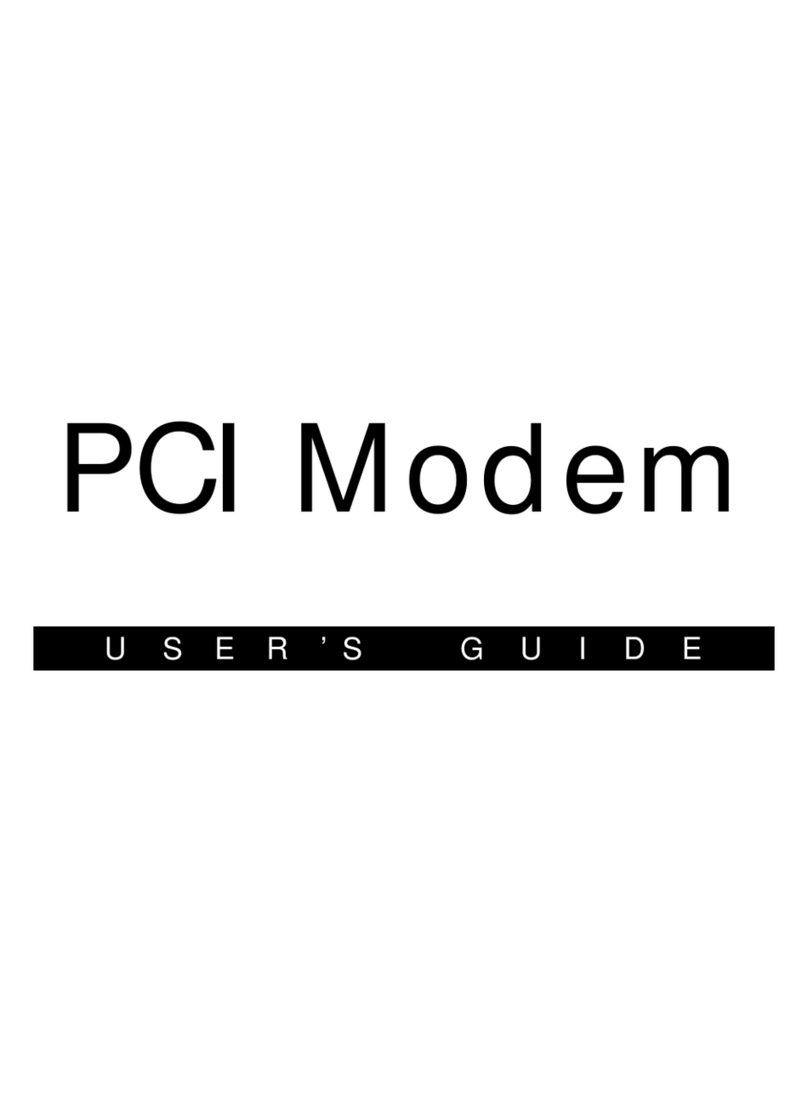
Hayes
Hayes H08-15531-EF User manual
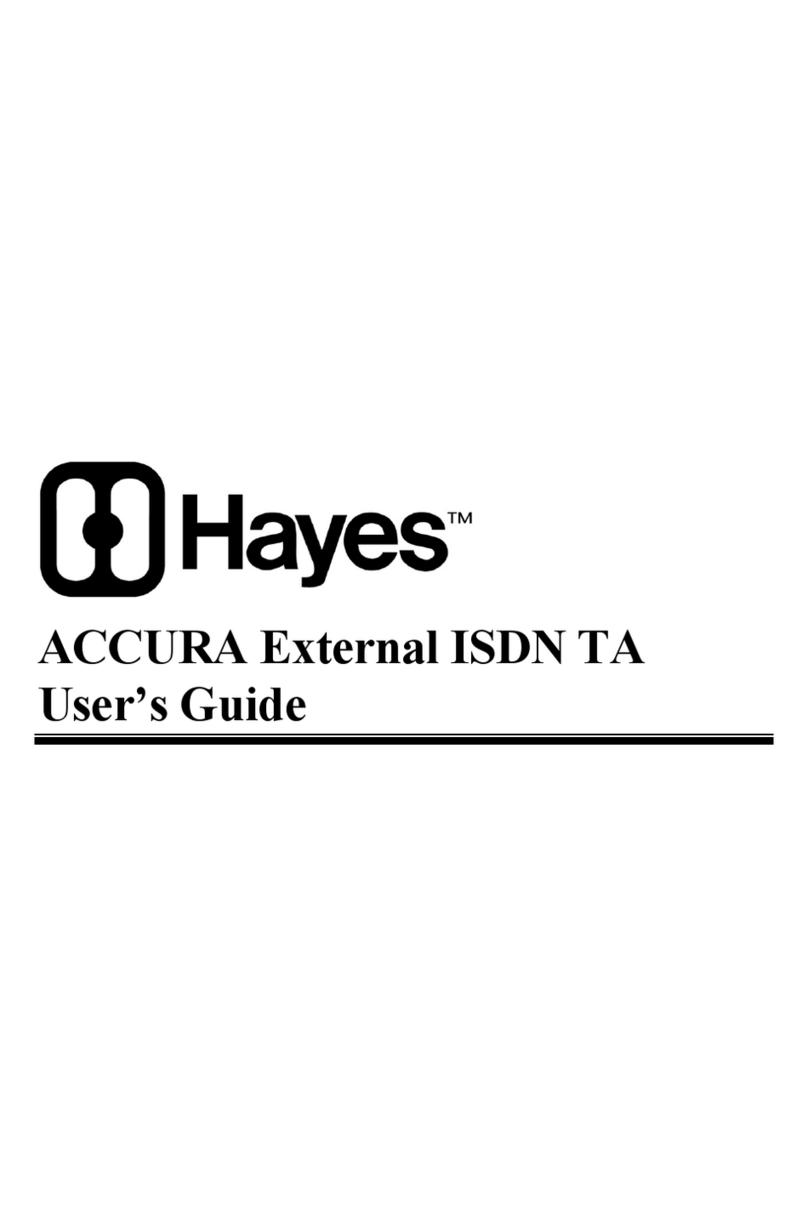
Hayes
Hayes ACCURA External ISDN TA User manual

Hayes
Hayes PC Card User manual

